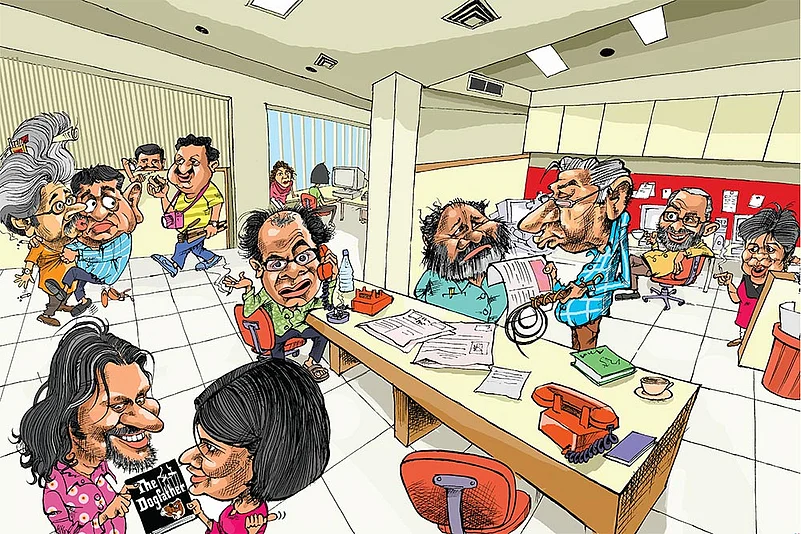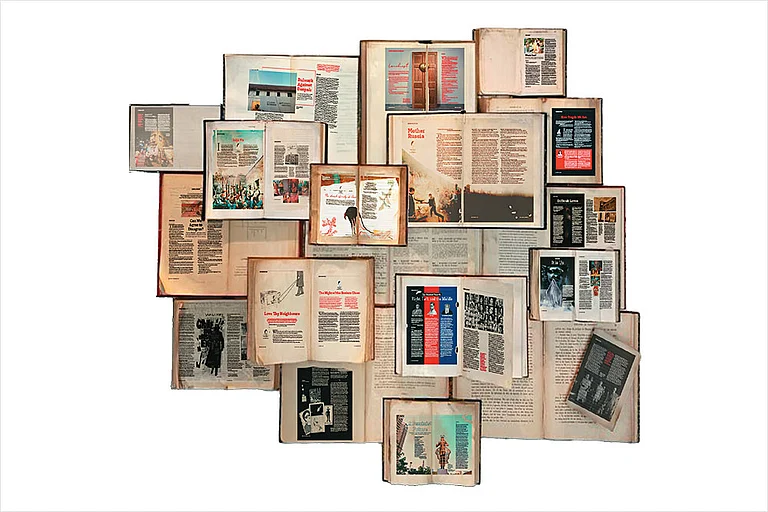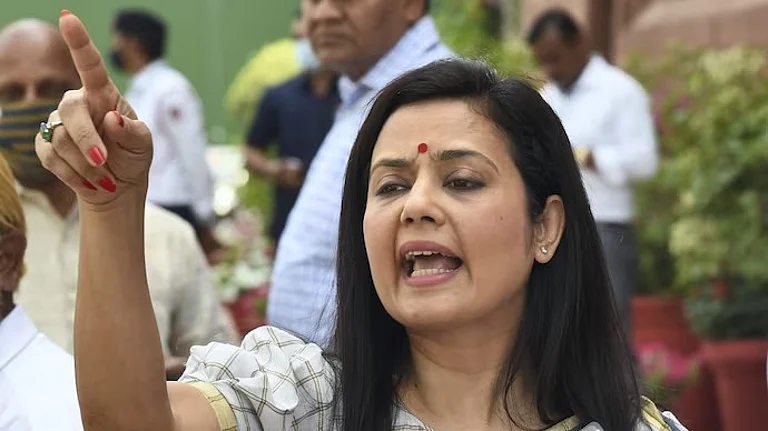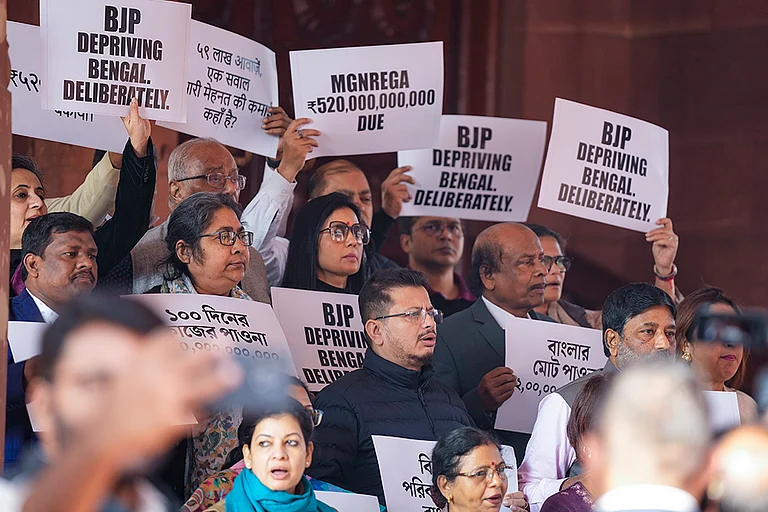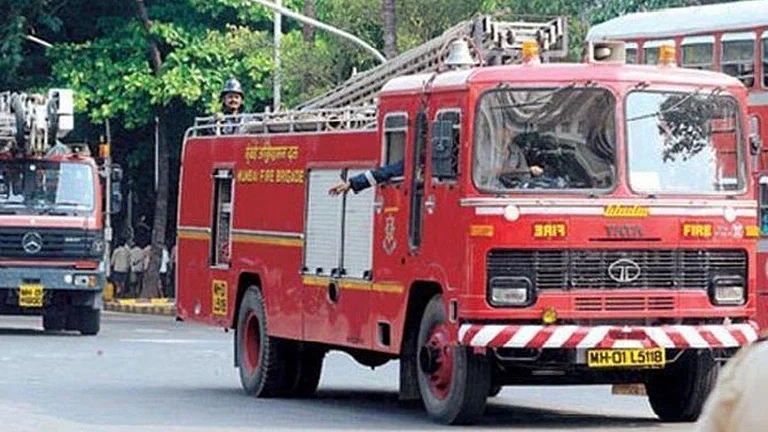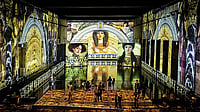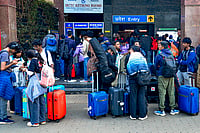Fifteen-odd journalists were slowly brought together over nearly three months in the summer of 1995 to bring out the “most exciting news weekly.” They dutifully came to the office every morning—two rooms hired at the now-defunct Lodhi Hotel that served as Outlook’s temporary editorial and business office—for the lunch hour. Then they waited some more for the clock to turn to an hour in which it could seem acknowledgeable that the day’s working hours had ended. The in-between hours were spent trying to expand the flock by the big boys. The others enriched themselves through casual exchanges around what was not right in other media organisations. Those three months were like a paid holiday. Until one day, the Boss said, “Playtime is over.”
AB-10 Safdarjung Enclave, on Chaudhury Jandu Singh Marg, was chosen as Outlook’s address. The editorial team whispered resistance to this choice. They red-flagged that the ministries and party offices would be far from AB-10. The fact that the Press Club of India, the only watering hole for the scribes until then, was at an inconvenient distance from AB-10 for most of the not-owning-a-transport editorial team bothered us more.
The nearest location to AB-10 one would tell an auto-driver in those pre-Google Maps days was Kamal Cinema. Kamal was a movie theatre that had long shut, falling to the vagaries of video piracy that had taken away cine-goers from theatres.
When we arrived at our new office, the listless neighbourhood around AB-10 inspired us little. The DDA-built business complex was mostly unoccupied and appeared desolate. Building housing and commercial complexes fell into the hands of a governmental body in post-independent India called the Delhi Development Authority (DDA.) Under its mixed land use policy, commercial centres were built in the vicinity of residential colonies so residents could find income opportunities in their own neighbourhoods. The AB-10 commercial centre is located on the edge of an upmarket sprawling South Delhi residential colony, Safdarjung Enclave.
The AB-10 Outlook office we moved into was stylishly furnished. The ground floor was assigned to the commercial section of the magazine, and the first and second floors were given to the editorial. The mezzanine was initially marked for the photography section, but those guys protested, saying the ceiling wasn’t high enough for them to stand without bending. So, the space was given to the system network guys. Before online data sharing came in, all the office computers were wired through a system called Local Area Network (LAN.)
In the newly set up office, everybody struggled to figure out how to log in to the network. The guys who made sure that this network worked, called the Systems Guys, behaved like prima donnas for the rest of the office staff. Their intercom would mostly remain off the hook. And when someone went looking for them to report a malfunctioning computer or a printer, they could seldom be found. Instead, one would see a few opened-up computers as if some serious repair work is being carried out. In the end, when one finally laid a hand on one of them, all these dudes did to make it work again was reboot the system.
The thought behind space management while laying out the office proved to be an important reason why Outlook’s office atmosphere remained so pleasant. There were no rooms and cabins, barring those for the two big bosses. Instead, sections and cubicles were partitioned by low wooden walls, allowing easy interactions between colleagues and section editors. One’s way of being in the office was unaffected due to its hierarchy. The second floor was where the Bureau, Copy Desk and Photography section were located; the first floor was taken by the two bosses, their secretarial offices, the Section Editors and the Design department. The first floor also had a conference room with a lavish, long wooden table and a television set. We literally witnessed the international cricketing birth of Saurav Ganguly and Rahul Dravid on that TV. There was a luxuriant, empty roof-top terrace where we played underarm cricket in the afternoon and sometimes organised office parties in the evening.
When we arrived in AB-10, our number, all departments put together, had risen to above 50 in Outlook’s Delhi office. Since there were no cafes in that complex, we often went to nearby restaurants in small groups by carpooling or autorickshaw. Those eat-outs are among my fondest memories of those times.
A small market built more like a horse stable separates this commercial complex’s two blocks that face each other. The complex’s parking lot is also between these blocks. The big boys of the group were given company cars—the top-end version of the Maruti 800. The two bosses had the biggest cars, driven by their chauffeurs. Fuel-guzzling relics of the permit-quota Raj, Padmini NE118 and Contessa. All cars put together would not fill the parking lot to even half. The stable-like market at the end of the parking lot had shops with signboards written in Russian. They sold leather goods, jackets and bags. Not much business activity seemingly happened in these shops. Occasionally, some white-skinned men or women, presumably nationals from the erstwhile Soviet-bloc countries, would visit these leather shops. There still was the halwai, Bengal Sweets, nothing Bengali about his sweets, Pratapgarh Paan Bhandar and Lahore Furniture, a shop selling charming old teak wooden furniture for a steal. Only stags in town knew about a certain dhaba across the road from Kamal Cinema on ` land that sold tandoori chicken for 25 rupees, available even at unearthly hours.
Fixed landlines were the only mode of telephonic communication. However, getting a landline connection was more complex than availing any other state-owned utility. Getting a new phone connection tested how well one knew the local level telephone department karmacharis. The sarkari contacts of Outlook’s journalists could not get telephone connections in our new office. It was ultimately a neighbourhood fixer who got the job done. We nicknamed him the one-armed Jack (the poor man had lost one of his arms.) This white safari-clad gent got four new telephone connections fixed in our office.
If one were to install a camera on the parking lot of AB-10 in a time-lapse mode from 1995 for the next decade, the photographs would reveal the changes as a microcosm of how India changed phenomenally and fast during this period.
A year after we moved in, the empty office spaces started to fill up, and the market, too, started to change in character. No one noticed when the leather shops closed down. Swish boulangeries, coffee shops, ice cream parlours, and pizzerias came up in the years that followed. A massage parlour, some called it seedy, was heard to exist at the rear-end of the complex. Many new kinds of businesses and the demographics they engaged with appeared as quickly as they disappeared around AB-10.
At some point, curiously, we noticed the parking lot getting swarmed by well-turned-out people, mostly men, with ties and buttoned-sleeved shirts, hanging around all day long. A pyramid-scheme company in the complex was enrolling members to sell its exorbitantly priced mattresses. In a pyramid scheme, the early members make a huge margin, and the ones who join towards the end of the scheme lose all their money because, by this time, the company folds up and disappears. All day, these people hanging around the parking lot would wait their turn to get interviewed to become members of the direct selling scheme of mattresses. Street vendors selling ties and belts appeared on the scene. These accessories also became available for renting for a few hours. A security guard at Outlook lost his job because the poor chap was caught letting the crowded gentry outside use the office toilets in return for a tip. And then, one day, the crowd wasn’t there, nor was the company.
From 1995 to 2005, photographs could reveal the changes as a microcosm of how India changed phenomenally and fast during this period.
The final and lasting makeover of the complex happened when the chicken dhaba from across the street marghat land moved to the market. We noticed for the first time that the dhabha was actually called the Rajinder Dhaba Express, RDX. All the class eateries in the complex perished, unable to compete with RDX’s pricing. The scene around AB-10 changed from a sleepy nook to a bustling food court with the opening of RDX.
The change had mixed outcomes. The complex began to look like an urban slum. When we came to the office in the mornings, we would get disgusted to walk through strewn chicken bones, leftover food and other trash littered from the previous evening. By the evening, all the mess would get cleaned. The smell of barbecued chicken filled the air. Four or five alcohol shops had opened in that small complex. Spirits went high as the evening turned dark. The cops had set up a makeshift watch tower; the loudspeaker atop repeated announcements that consumption of alcohol in public spaces was an offence. Cops wielding breath-analysers stopped people driving out from the parking lot. Business was brisk for everyone in the market.
There must have been an X-factor about Outlook’s founding team that gave the newly-born media house a flying start; the people who joined subsequently continue to carry forward the good work. Now, for over a quarter century. However, when we started, few had given Outlook a chance for its longevity. Print journalism was not where investors were looking to hedge their money. TV as a news medium was booming. A week seemed too long a time for the public to wait in an emerging age of 24X7 news channels. The news magazine was the media of the 70s and the 80s—many had shut down in the 90s. There seemed room for only one player, and that space was taken by an established fortnightly. There were doubts about how long our famous editor would last in his job. He had left his earlier jobs after short stints. The papers he founded or edited before had been fine publications but were commercial non-starters. Most of them folded up after he left. But something worked this time.
By the time we were celebrating our first anniversary at AB-10, Outlook’s circulation had reached a kissing distance of the magical one hundred thousand figure. Still, it was only a quarter of what our established competitor, the fortnightly, sold. However, Outlook’s weekly cycle was increasingly taking out the sting from the fortnightly giant. Someone from our editorial team brought back a rumour that delighted us to no end. The fortnightly magazine’s editor was heard to have dismissed Outlook in the social circuit as “a good-looking rag brought out by good-looking people.” We were happier about the second part of the editor’s analysis.
All the good times we had at the workplace, and the accolades we got from our peers would not have been possible without Outlook’s owner, Rajan Raheja. He kept putting his money in Outlook without interfering with our business. The editorial had a patron-priest kind of relationship with Mr. Raheja. Owing to a story Outlook published, the Vajpayee government got the Income Tax department to raid his offices and home as a blatant act of retribution. Everyone in the media industry said that the Rahejas would sell out of the publishing business after this horrific episode. But Mr. Raheja showed courage and stamina in continuing to support and fund Outlook. In those earlier years, Mr Raheja would come to Delhi to meet some of us over dinner at a five-star restaurant once every year. He only had praises for us.
Our former colleague from Outlook’s dream-team days, now a Rajya Sabha MP, recently described those times in her maiden parliamentary speech as the golden age of journalism.
A page from that golden age was written within AB-10.
MORE FROM THIS ISSUE
Bishwadeep Moitra is the former Executive Editor of Outlook. He is the co-founder of Silaiwali, a social enterprise
(This appeared in the print as 'Once Upon A Time, In AB-10')






